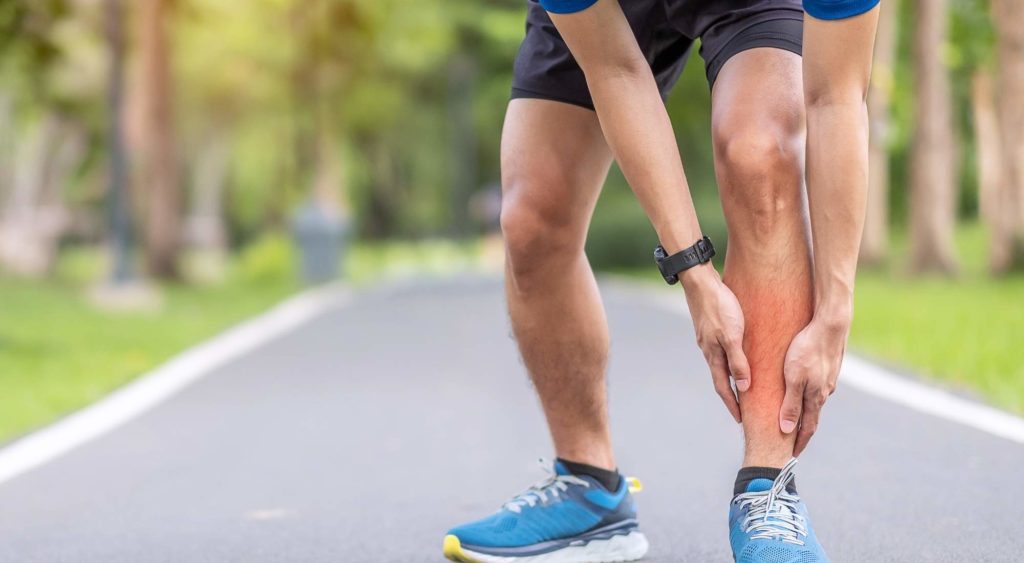Shin Splints

Physical Therapy for Shin Splints – Information, Exercises, and More
The pain along the front and outside of your shins when you’re working out is wearing you down.
Sometimes it aches and throbs, while other times it feels like a razor blade is zipping down your legs.
Shin splints are no joke.
If you’ve been suffering from the pain of shin splints, then you know how uncomfortable they can be.
You may be wondering if physical therapy for shin splints is an option and how it might help.
In this quick guide, we share information, exercises, and everything you need to know about physical therapy for shin splints.

Contents
- What Are Shin Splints?
- What Causes Shin Splints?
- Shin Splints Symptoms
- 9 Shin Splints Treatments
- Can a Physical Therapist Help With Shin Splints?
- 3 Physical Therapy Exercises For Shin Splints
- How In Motion O.C. Can Help With Shin Splints
What Are Shin Splints?
Shin splints, also known as medial tibial stress syndrome, refer to the inflammation of the …
- Muscles
- Tendons; and
- Bone tissue
… around the large bone in the front of your lower leg.
What Causes Shin Splints?
Shin splints develop when the muscles and bone tissues in your leg become overworked by repetitive activities.
Many times, shin splints occur after you make sudden changes in your physical activity. For example, maybe you’ve increased:
- The intensity of your workouts
- How many days you’re exercising each week; or
- The length of your runs
Shin splints may also be caused by:
- Stress fractures
- Tendinitis
- Chronic exertional compartment syndrome
- Having flat feet or unusually high arches; or
- Exercising without the proper footwear
The following people are at high risk for shin splints:
- Runners
- Dancers; and
- Those in the military
Shin Splints Symptoms
The most common symptom of shin splints is pain on the outside or front of your shins or the inside of your lower leg, above your ankle.
The symptoms of shin splints may be:
- Sharp
- Razor-like
- Dull; and/or
- Throbbing
They may also occur during and after exercise and be aggravated by touching the sore area.
9 Shin Splints Treatments
Treatments for shin splints include the following modalities:
#1: Rest
Shin splints are typically caused by overuse.
Many times, several weeks of rest from the activity that caused the pain can be a positive step towards healing.
Lower impact aerobic activity, such as:
- Swimming
- Riding a stationary bike; or
- Using an elliptical trainer
#2: Anti-Inflammatory Medications
These medications may reduce pain and swelling and include:
- Ibuprofen
- Aspirin; and
- Naproxen
#3: Ice
Applying cold packs several times a day, for 20 minutes at a time, may relieve pain and help to reduce swelling that results from shin splints.
#4: Manual Techniques
Manual techniques for shin splints include relieving muscle tension and trigger points.
A physical therapist may use deep stroking massage or sustained compression to reduce pain and speed healing.
#5: Kinesio Taping
Kinesio tape lifts the superficial tissues in the affected area.
Kinesio tape can help to promote healing by:
- Stimulating the nerve endings that relax your muscles; and
- Allowing waste products to circulate out of the affected area
#6: Compression
Wearing an elastic compression bandage or compression stockings may prevent additional swelling.
#7: Orthotics
If you have flat feet or recurring problems with shin splints, you may benefit from orthotics to help align and stabilize your ankle and foot.
#8: Flexibility Exercises
Stretching your lower leg muscles may prove helpful in making your shins feel better.
#9: Supportive Shoes
Wearing shoes with plenty of support and cushioning during the day may help reduce stress on your shins.
Can a Physical Therapist Help With Shin Splints?
Yes!
Studies show that a physical therapist can help with shin splints.
Physical therapy protocol for shin splints may include the use of the following treatments:
- Exercises
- Kinesio taping
- Manual techniques
- Orthotics
3 Physical Therapy Exercises For Shin Splints
The following exercises may also help relieve shin splints and get you back to normal activities.
Be sure to always warm up and stretch well before each exercise.
#1: Seated Calf Stretch
- Sit on the floor with your knees straight.
- Place a towel or band around your foot and use it to pull your foot into a flexed position.
- Hold this position for 30 seconds.
- Repeat 5x.
Do this three times each day.
#2: Heel Walk
- Stand in place.
- Lift the front of your foot off of the floor, keeping your heels flat on the floor.
- Hold the position for 10 seconds.
- Slowly lower the front of your foot back to the floor.
- Repeat for three sets of 10, increasing to three sets of 30.
Do this three times per day.
#3: Standing Ankle Dorsiflexion
- Stand facing a wall, with your feet about 18 inches away from the wall.
- Keep your knee straight and your heel on the floor.
- With the front bottom part of your foot against the wall, lean forward slightly until you feel a stretch in your calf muscles.
- Repeat for three sets of 10, increasing to three sets of 30.
Do this three times per day.
How In Motion O.C. Can Help With Shin Splints
If you’re suffering from shin splints, In Motion O.C. can help!
Check out our patient case studies and testimonials and see for yourself why we’ve been Voted #1 Physical Therapy Clinic in the entire country on Yelp.
All of our physical therapy treatments are conducted by our highly-trained physical therapists in our state-of-the-art facilities.
We’re committed to bringing relief and comfort to each and every patient we treat.
Give us a call today to find out more about physical therapy for shin splints.


